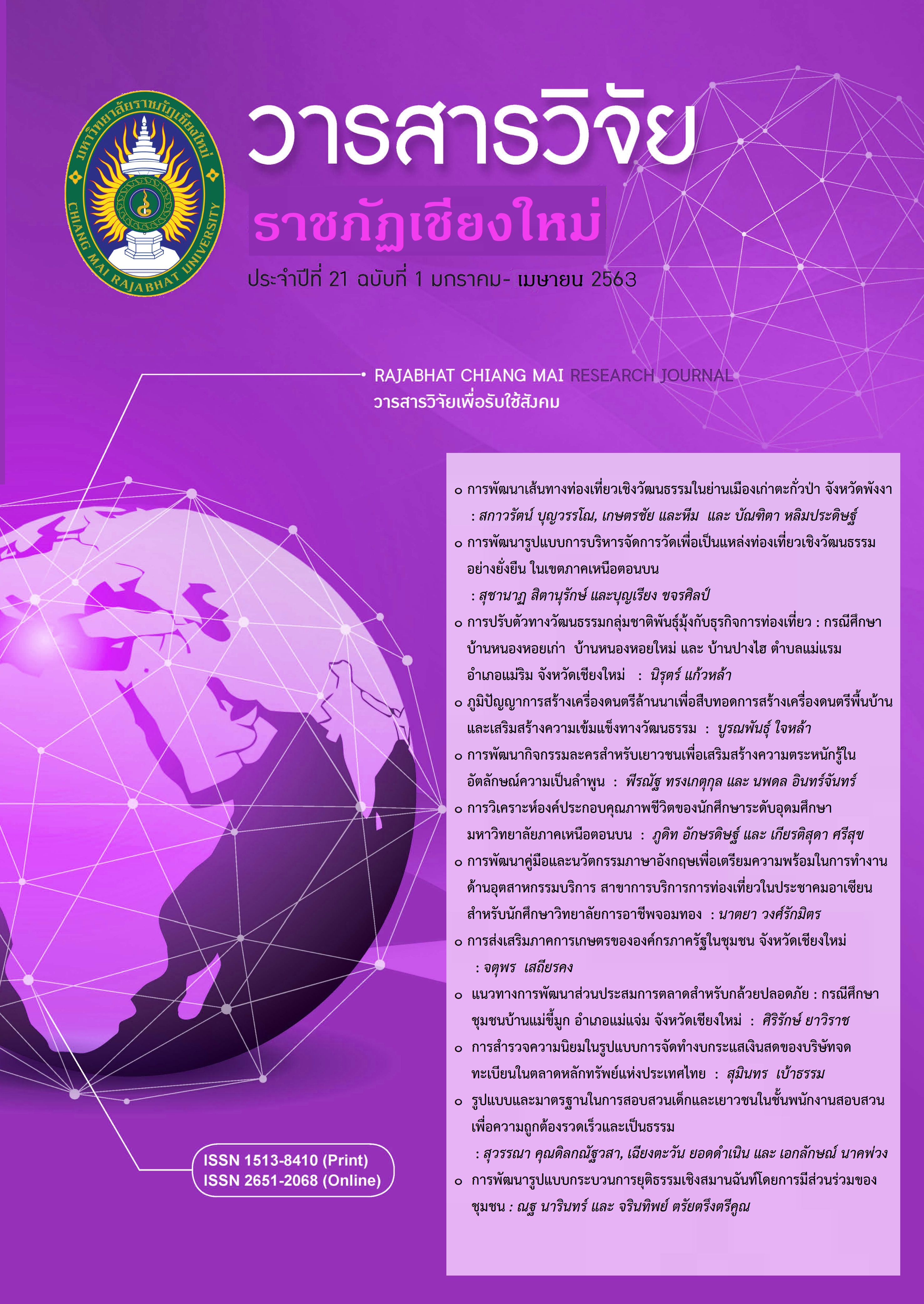Promoting the Agriculture of Chiang Mai Local Community
DOI:
https://doi.org/10.14456/rcmrj.2020.219053Keywords:
Agricultural community, ASEAN community, ASEAN economic competition, Sufficiency economyAbstract
This research aims to study and develop the potentiality of agriculture of Chiang Mai communities. It is the qualitative research and were supported by quantitative analysis from primary data of 6 groups of agriculturists and willing to attend the project. All of these 6 groups have potentiality in which governmental organizations promoted agriculture in communities. SWOT analysis, participatory action research and Michael E. Porter’s diamond model were used in this study. Descriptive statistics and 6 dimensions were used to evaluate the achievement of the project in order to display and look for guidelines that government should promote agriculture in Chiang Mai communities to compete in ASEAN.
The research found that the strengths of all these 6 groups were that members were capable and specialized in production, marketing, cultivating, processing and public relations. Their weaknesses were that they could not manage farm and areas of planting efficiently. They have less power to negotiate with middlemen. They however were supported in knowledge and budgets by both government and private organizations. Their threats were that it has a high competition in marketing both price and quantity and marketing lack of varieties. There are six items of guidelines to promote agriculture of governent in Chiang Mai communties to compete in ASEAN . The most important item was that government should promote budgets, knowledge, production , accounting and marketing.
Downloads
References
กรมส่งเสริมการเกษตร. (2562). การจัดตั้งศูนย์บริการและถ่ายทอดเทคโนโลยีการเกษตรประจำตำบล. สืบค้นจาก https://agtech.doae.go.th/
จินดา ขลิบทอง. (2554). “กระบวนการวิจัยทางส่งเสริมการเกษตร” ในประมวลสาระชุดวิชาการวิจัย และสถิติ เพื่อการส่งเสริมและพัฒนาการเกษตร. นนทบุรี: มหาวิทยาลัยสุโขทัยธรรมาธิราช. สาขาวิชาเกษตรศาสตร์และสหกรณ์.
ดุษฎี ณ ลำปาง. (2543). การวางแผนและประเมินผลโครงการส่งเสริมการเกษตร. เชียงใหม่: ภาควิชาส่งเสริมและเผยแพร่การเกษตร คณะเกษตรศาสตร์ มหาวิทยาลัยเชียงใหม่.
ธนาคารแห่งประเทศไทย. (2562). ข่าว ธปท.เรื่อง แถลงข่าวเศรษฐกิจและการเงินภาคเหนือ เดือนพฤศจิกายน 2562. เชียงใหม่.
ธนุพงษ์ บุญญประภา. (2556). ความต้องการโครงการส่งเสริมการเกษตรของเกษตรกร ในศูนย์พัฒนาโครงการหลวงแกน้อย อำเภอเชียงดาว จังหวัดเชียงใหม่. เชียงใหม่: มหาวิทยาลัยแม่โจ้.
นันทิยา หุตานุวัตร. (2546). SWOT การวางแผนกลยุทธ์ธุรกิจชุมชน: คณะเกษตรศาสตร์ มหาวิทยาลัยอุบลราชธานี สถาบันชุมชนท้องถิ่นพัฒนา. สืบค้นจาก https://www.jit-jai-d.blogspot.com/2007/08/swot.html
เบญจมาศ สันต์สวัสดิ์ และปภากร สุทธิภาศิลป์. (2562). แนวทางในการส่งเสริมการผลิตสินค้าเกษตรอินทรีย์เพื่อให้มีศักยภาพการแข่งขันในประชาคมอาเซียน. วารสารวิจัยราชภัฏเชียงใหม่, 20(1), 19-29.
พันธ์จิต สีเหนี่ยง, โชตนา ลิ่มสอน, เสาวลักษณ์ ฤทธิ์อนันต์ชัย และชัยกร สีเหนี่ยง. (2557). การวิเคราะห์สภาพแวดล้อมและศักยภาพ (SWOT Analysis) ระบบส่งเสริมการเกษตรในประเทศไทย: กรณีศึกษาพื้นที่ภาคกลาง. กรุงเทพมหานคร: (ม.ป.พ.).
วีระศักดิ์ สมยานะ. (2562). การเพิ่มประสิทธิภาพการผลิตสินค้าเกษตรบนฐานเศรษฐกิจพอเพียง. วารสารวิจัยราชภัฏเชียงใหม่, 20(2), 14-27.
สำนักงานเกษตรและสหกรณ์จังหวัดเชียงใหม่. (2563). องค์ความรู้และฐานข้อมูล. สืบค้นจาก https://www.moac-info.net/ChiangMai/
Michael E. Porter. (1990). The Competitive Advantage of Nations: With a new Introduction. New York: Free Press.
Miles, MB. and Huberman, AM. (1994). Qualitative Data Analysis. (2nd edition). Thousand Oaks, CA: Sage Publications.
Downloads
Published
How to Cite
Issue
Section
License
1. Articles, information, content, images, etc published in the “Community and Social Development Journal” are copyrighted by the Community and Social Development Journal, Chiang Mai Rajabhat University. In order to properly distribute the articles through print and electronic media, the authors still hold the copyright for the published articles under the Creative Commons Attribution (CC BY) license, which allows the re-distribution of the articles in other sources. References must be made to the articles in the journal. The authors are responsible for requesting permission to reproduce copyrighted content from other sources.
2. The content of the articles appearing in the journal is the direct responsibility of the article authors. The editorial board of the journal does not necessarily agree with or share any responsibility.














